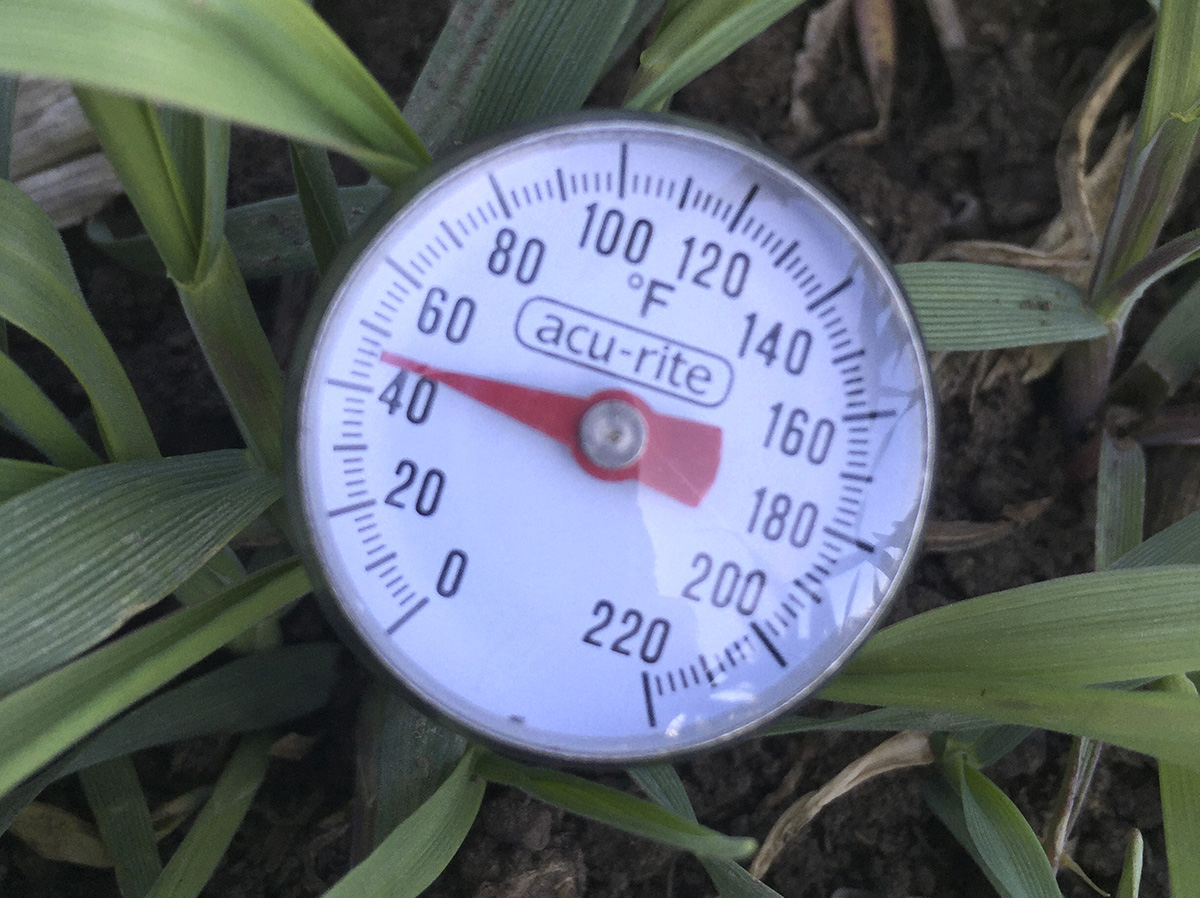
By Tyler Williams, Extension Educator, Lancaster Co.
Every year in eastern Nebraska we seem to deal with cold and/or wet soils during planting. This limits the windows of opportunity for good planting conditions and many operations will push the limits when getting their crops in the ground.
CHECK SOIL TEMPERATURE
It is best to check the soil temperature in your field down to a depth of 4 inches. You can use the Nebraska Mesonet (https://mesonet.unl.edu) or CropWatch (https://cropwatch.unl.edu) to find soil temperatures at a nearby station. The sources listed above provide a daily average soil temperature and a 7-day average soil temperature. It is important to check temperatures daily and try to get a 7-day average near the optimal temperature of 50°F. Check the soil temperature at the same time each day (do it in the morning) because the temperature can vary significantly throughout the day, especially in bare, dry soils, which can vary 10–15°F from morning to afternoon.
COLD TOLERANCE OF SEEDS
Before planting, check the seed tag or check with your dealer regarding the cold tolerance of your hybrid/variety. Hybrids and varieties vary in their cold tolerance and those that are more cold tolerant should be planted first.
Imbibitional chilling, which is when the seed takes in water below 50°F (likely in the mid- to low-40s) within 48 hours of planting corn (24 hours of soybeans), can impact seed germination and growth, so pay close attention to the weather forecast. Soil temperatures dropping below 50°F after that 48-hour window do not create as big of an issue.
OPTIMAL PLANTING DATE
Many use a calendar date for planting, often based on the crop insurance date; however, the soil temperature can vary significantly from year to year, so this may not be the best method. For example, for the last 30 years, the soil temperature at the Eastern Nebraska Research and Extension Center near Mead on April 10 of each year averaged 49°F, but ranged from 37°F (1997) to 61°F (2011). The average temperature for this station-date is near the optimal planting temperature, but the variation is significant.
Research done in Iowa has shown the optimum planting windows for corn, to obtain at least 98 percent yield potential, range from April 17–May 8 for southwest Iowa (closest location to southeast Nebraska). The optimum window for soybean planting is late-April through mid-May, again, if conditions and forecasts are adequate.
INCREASING WETNESS
Moisture conditions in your field will also play a role in finding the optimum planting window. Planting in wet soils can cause tire compaction, side-wall compaction, tire ruts, etc. There may also be a risk of soil-borne pathogens if soils remain saturated for an extended period after planting.
Opportunities for dry weather keep getting smaller and smaller over time due to an increasing precipitation trend in the spring. In 2015, Shulski, et al. found that 68 percent of the stations in Nebraska showed a significant trend of 8 more days of measurable precipitation in the spring (from 1895–2012). Just in the month of April, every climate division in Nebraska has seen an increasing 30-year trend of >0.4”/decade of precipitation (1987–2016). This equates to nearly an extra 1.5 inches of precipitation in April, as compared to 30 years ago.
Obviously, finding an extended period of optimum planting conditions is challenging, so take advantage of any window of opportunity with soil temperatures remaining above 50°F for 48 hours and adequate soil conditions. Large planters, auto-steer and other technology should help increase the number of acres covered in a short window.
AGRITOOLS MOBILE APP
Nebraska Extension’s AgriTools mobile app is a useful tool, which uses your GPS location to look at interpolated soil temperature from the Nebraska Mesonet. The app provides the 5-day forecast from the National Weather Service, among other information. AgriTools is available for iPhone and Android devices.
Sources:
• Shulski, et. al. 2015. A Historical Perspective on Nebraska’s Variable and Changing Climate. Great Plains Research 25 (Fall 2015): 109-120
• NOAA National Centers for Environmental Information, Climate at a Glance: Global Mapping. http://www.ncdc.noaa.gov/cag
• High Plains Regional Climate Center – Web Data Access. https://hprcc.unl.edu
• CropWatch, University of Nebraska-Lincoln, Institute of Agriculture and Natural Resources. https://cropwatch.unl.edu
• Nebraska Mesonet, Nebraska State Climate Office, University of Nebraska – Lincoln. https://mesonet.unl.edu